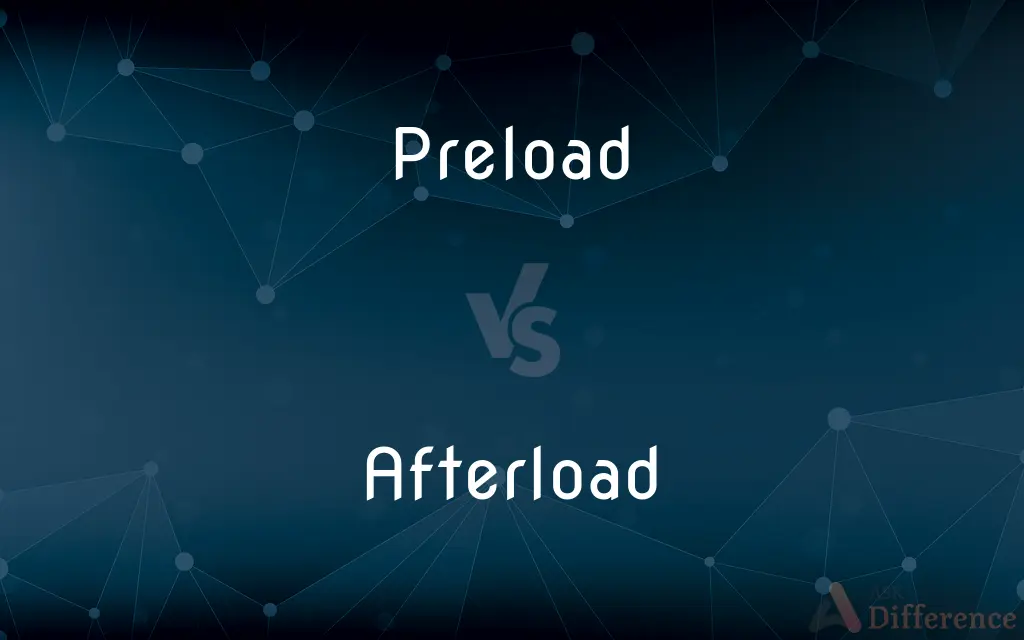Preload vs. Afterload — What's the Difference?
By Urooj Arif & Fiza Rafique — Updated on April 18, 2024
Preload refers to the end-diastolic volume that stretches the ventricles to their greatest dimensions under variable physiologic demand; afterload is the resistance left ventricles must overcome to circulate blood.

Difference Between Preload and Afterload
Table of Contents
ADVERTISEMENT
Key Differences
Preload is primarily concerned with the volume of blood returning to the heart, specifically to the ventricles before contraction. It affects the stretch of the cardiac muscle fibers, thereby influencing the force of the subsequent contraction. Whereas, afterload refers to the resistance against which the heart must pump blood, primarily affected by arterial pressure and vascular resistance.
In terms of cardiac function, preload can be thought of as a determinant of cardiac output based on the Frank-Starling law, which states that the more the heart muscle is stretched during filling, the more forcefully it contracts. On the other hand, afterload is seen as a load that the heart must overcome to eject blood during systole.
Preload is significantly influenced by venous blood return and the functioning of the atria. An increase in preload usually indicates a higher volume of blood being returned to the heart, often seen in fluid overload conditions. Conversely, afterload is increased in conditions like hypertension and vasoconstriction, which places more stress on the heart to pump blood effectively.
The measurement of preload can be approximated using central venous pressure and ventricular end-diastolic volume, which provide insights into the filling pressure and volume of the heart before contraction. In contrast, afterload is assessed through systemic vascular resistance and arterial pressure, which reflect the resistance to blood flow in the vascular system.
Managing conditions affecting preload and afterload involves different therapeutic approaches. For preload, diuretics and venodilators are commonly used to reduce fluid volume and venous return. Meanwhile, afterload is managed with anti-hypertensives such as ACE inhibitors and vasodilators that reduce arterial pressure and resistance.
ADVERTISEMENT
Comparison Chart
Definition
Volume of blood in ventricles at end-diastole
Resistance left ventricle faces during blood ejection
Influences
Ventricular stretch and cardiac fiber tension
Arterial pressure and vascular resistance
Physiological role
Determines force of contraction via Frank-Starling mechanism
Determines cardiac workload during systole
Measurement
Central venous pressure, ventricular end-diastolic volume
Systemic vascular resistance, arterial pressure
Clinical management
Diuretics, venodilators to manage volume
ACE inhibitors, vasodilators to manage resistance
Compare with Definitions
Preload
The initial stretching of the cardiac myocytes prior to contraction.
Preload affects the stroke volume of the heart according to the Frank-Starling law.
Afterload
Affects the heart's workload during blood ejection.
Managing afterload is crucial for patients with hypertension.
Preload
Determined by venous return and ventricular compliance.
Preload can be reduced with diuretics in patients with heart failure.
Afterload
The resistance that the heart must overcome to eject blood during systole.
High afterload can lead to hypertensive heart disease.
Preload
Volume of blood in the ventricles at the end of diastole.
Increased preload can indicate fluid overload.
Afterload
Assessed by measuring arterial pressure and resistance.
Regular monitoring of arterial pressure helps in managing afterload.
Preload
Measured indirectly by central venous pressure.
Central venous pressure readings help estimate preload in clinical settings.
Afterload
Managed with medications that affect blood pressure and vascular tone.
Vasodilators are often prescribed to reduce afterload.
Preload
To load (something) in or onto a device or conveyance in advance of use or need
Preloaded the dirty socks in the washer to allow them to soak for half an hour.
Afterload
Determined by arterial pressure and vascular resistance.
Afterload increases with higher systemic vascular resistance.
Preload
To load something into or onto (a device or conveyance) in advance of use or need
The manufacturers preloaded the computer with antivirus software.
Afterload
Afterload is the pressure that the heart must work against to eject blood during systole (ventricular contraction). Afterload is proportional to the average arterial pressure.
Preload
To load something in advance of use or need
If you preload, you can play the game as soon as it is released.
Afterload
(physiology) The load on a working muscle from a constant opposing force
Preload
The act of preloading
The app is now available for preload.
Preload
An instance of preloading
Preloads of the game increased following the positive review.
Preload
(transitive) To load in advance (used especially in reference to software installed on a computer prior to sale).
My computer came preloaded with wordprocessor software.
Preload
To drink (cheaper) alcohol at home before going out socially.
That nightclub is so expensive. Let's preload at your flat.
Preload
(anatomy) The end diastolic pressure that stretches the right or left ventricle of the heart to its greatest geometric dimensions under variable physiologic demand.
Preload
(engineering) The internal application of stress to certain mechanical systems.
Preload
Influences the force of heart contraction.
A higher preload leads to a more forceful heart contraction.
Common Curiosities
What conditions can increase afterload?
Conditions that increase afterload include hypertension, aortic stenosis, and increased systemic vascular resistance.
How does preload affect blood pressure?
Preload primarily affects cardiac output, which can influence blood pressure indirectly; a higher preload can lead to higher blood pressure if not balanced by other cardiovascular mechanisms.
What role does the autonomic nervous system play in regulating preload and afterload?
The autonomic nervous system regulates preload and afterload through heart rate, myocardial contractility, and vascular tone adjustments, influencing both venous return and arterial resistance.
What diagnostic tools are used to assess preload and afterload in a clinical setting?
Clinicians use echocardiograms, cardiac catheterization, and blood pressure measurements to assess preload and afterload values.
What factors increase preload?
Factors that increase preload include fluid overload, venous constriction, and conditions that enhance venous return to the heart.
What is the impact of aging on preload and afterload?
Aging typically leads to decreased compliance of the heart and blood vessels, potentially increasing afterload and altering preload handling.
Does afterload have a direct relationship with stroke volume?
Yes, increased afterload generally decreases stroke volume because the heart must work harder against greater resistance, which can reduce the efficiency of ventricular ejection.
How do conditions like heart failure affect preload and afterload?
In heart failure, preload often increases due to compromised cardiac function and fluid retention, while afterload may also increase as a compensatory mechanism to maintain cardiac output.
Are there specific drugs that target only preload or afterload?
Yes, drugs such as diuretics and venodilators primarily target preload, while vasodilators and ACE inhibitors mainly affect afterload.
What are the risks of not managing preload and afterload effectively in patients with cardiovascular diseases?
Poor management can lead to exacerbated cardiac symptoms, worsening heart failure, increased risk of stroke, and other severe cardiovascular complications.
Can dietary choices influence preload and afterload?
Yes, high salt intake can increase blood volume, thus increasing preload, whereas a diet high in saturated fats and cholesterol can increase arterial stiffness and afterload.
Can preload and afterload be modified for athletic training?
Yes, both can be influenced by physical conditioning; endurance training can increase ventricular compliance, affecting preload, while strength training can influence vascular resistance and afterload.
What are the symptoms of abnormal preload and afterload?
Symptoms may include shortness of breath, edema, and high blood pressure, indicating fluid imbalance and cardiovascular strain.
How do preload and afterload interact during physical activity?
During physical activity, preload increases due to enhanced venous return, while afterload may decrease due to exercise-induced vasodilation, improving cardiac output.
What lifestyle modifications are recommended for managing preload and afterload?
Lifestyle changes such as reducing salt intake, maintaining a healthy weight, regular exercise, and avoiding excessive alcohol consumption can help manage both preload and afterload effectively.
Share Your Discovery

Previous Comparison
Inflation vs. Deflation
Next Comparison
Onshore vs. OffshoreAuthor Spotlight
Written by
Urooj ArifUrooj is a skilled content writer at Ask Difference, known for her exceptional ability to simplify complex topics into engaging and informative content. With a passion for research and a flair for clear, concise writing, she consistently delivers articles that resonate with our diverse audience.
Co-written by
Fiza RafiqueFiza Rafique is a skilled content writer at AskDifference.com, where she meticulously refines and enhances written pieces. Drawing from her vast editorial expertise, Fiza ensures clarity, accuracy, and precision in every article. Passionate about language, she continually seeks to elevate the quality of content for readers worldwide.














































